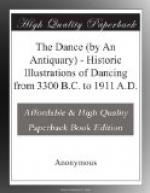[Illustration: Fig. 57.—Spring dancing away from winter. From a drawing by Watteau.]
[Illustration: Fig. 58.—The Misses Gunning dancing. End of the 18th century, from a print by Bunbury, engraved by Bartolozzi.]
[Illustration: Fig. 59.—Dancing. Close of the 18th century. From Derby ware.]
[Illustration: Fig. 60.—Spanish dance in the Hall of Saragoza, 19th century.]
CHAPTER VI.
THE MODERN THEATRE DANCE.
Although the theatrical ballet dance is comparatively modern, the elements of its formation are of the greatest antiquity; the chorus of dancers and the performances of the men in the Egyptian chapters represent without much doubt public dancing performances. We get singing, dancing, mimicry and pantomime in the early stages of Greek art, and the development of the dance rhythm in music is equally ancient.
The Alexandrine Pantomime, introduced into Rome about 30 B.C. by Bathillus and Pylades, appears to have been an entertainment approaching the ballet.
In the middle ages there were the mysteries and “masks”; the latter were frequent in England, and are introduced by Shakespere in “Henry VIII.”
In Italy there appears to have been a kind of ballet in the 14th century, and from Italy, under the influence of Catharine de’ Medici, came the ballet. Balthasar di Beaujoyeulx produced the first recorded ballet in France, in the Italian style, in 1582. This was, however, essentially a Court ballet.
The theatre ballet apparently arose out of these Court ballets. Henry III. and Henry IV., the latter especially, were very fond of these entertainments, and many Italians were brought to France to assist in them. Pompeo Diabono, a Savoyard, was brought to Paris in 1554 to regulate the Court ballets. At a later date came Rinuccini, the poet, a Florentine, as was probably Caccini, the musician. They had composed and produced the little operetta of “Daphne,” which had been performed in Florence in 1597. Under these last-mentioned masters the ballet in France took somewhat of its present form. This passion for Court ballets continued under Louis XIII. and Louis XIV.
[Illustration: Fig. 61.—Mlle. de Camargo. After a painting by Lancret, about 1740 A.D.]
Louis XIII. as a youth danced in one of the ballets at St. Germain, it is said at the desire of Richelieu, who was an expert in spectacle. It appears that he was encouraged in these amusements to remedy fits of melancholy.
Louis XIV., at seven, danced in a masquerade, and afterwards not only danced in the ballet of “Cassandra,” in 1651, but did all he could to raise the condition of the dance and encourage dancing and music. His influence, combined with that of Cardinal Richelieu, raised the ballet from gross and trivial styles to a dignity worthy of music, poetry and dancing. His uncle, Gaston of Orleans, still patronized the grosser style, but it became eclipsed by the better. Lulli composed music to the words of Moliere and other celebrities; amongst notable works then produced was the “Andromeda” of Corneille, a tragedy, with hymns and dances, executed in 1650, at the Petit Bourbon.




